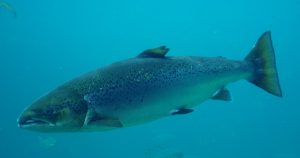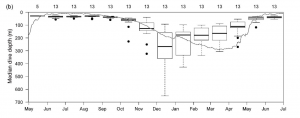Investigating Atlantic Salmon Dive Behavior in the Norwegian and Barents Seas
By Grant Voirol, SRC Intern
Atlantic salmon, Salmo salar, are both an economically and ecologically important organism. An anadromous fish, Atlantic salmon spend most of their lives at sea before swimming into freshwater rivers to spawn. While at sea, Atlantic salmon periodically migrate to depths deeper than 10 meters. One proposed model of their diving behavior is that the salmon dive to deeper colder waters to feed before returning to shallower warmer water to digest. In this way, they can maximize their energy conservation (Reddin et al 2004). However, in colder waters of the most northern Atlantic, temperatures of shallower water are not significantly warmer than the depths that salmon can reach. So what factors govern Atlantic salmon diving behavior in these colder waters?

Atlantic salmon are both popular sport fish throughout the Atlantic as well as important predators and prey. Photo: Hans-Petter Fjeld (CC-BY-SA).
A recent study sought to find out. To do so, researchers studied post-spawning Atlantic salmon in the Norwegian and Barents Seas over season and daily timescales. Three populations from the three rivers Orkla, Alta, and Neiden, were caught and tagged using pop-up satellite archival tags (PSATs) and data storage tags (DSTs). PSATs measure temperature and depth and are attached externally to the salmon. They release themselves from the fish if a predetermined period of days goes by, the fish dives to a depth that will harm the tag (1200 meters), or the tag registers a constant depth, usually meaning the fish has died. Once they release themselves, the tags send a signal to satellites where the data collected as well as its position can be downloaded. DSTs are inserted internally in the salmon and measure temperature and depth at a much higher resolution. However, since the tags are inserted into the salmon, these salmon must be recaptured in order to retrieve the data. Recapture was dependent on fishers who would receive a reward for returning the tags to the researchers.
The findings show that the three groups of salmon displayed similar patterns of dive behavior during the sampled period. On the seasonal time scale, salmon went to deeper depths during winter and spring following the depth of the mixed layer (Figure 1). On daily timescales, the salmon occupied greater depths during daylight hours and returned to nearer to the surface during nighttime hours (Hedger et al. 2017).

Median dive depth per month. Solid line shows depth of the mixed layer. Increases in dive depth occur during the months of November to May. (Hedger et al. 2017)
A better understanding of the distribution and behavior of different populations of Atlantic salmon is important in order to know if different management practices need to be employed in different areas. Furthermore, this information gives us a better picture of the role that Atlantic salmon play in the Northeast Atlantic as both a predator and prey species.
Works Cited
Hedger RD, Rikardsen AH, Strøm JF, Righton DA, Thorstad EB, Næsje TF (2017) Diving behaviour of Atlantic salmon at sea: effects of light regimes and temperature stratification. Mar Ecol Prog Ser 574:127-140.
Reddin DG, Friedland KD, Downton P, Dempson JB, Mullins CC (2004) Thermal habitat experienced by Atlantic salmon (Salmo salar L.) kelts in coastal Newfoundland waters. Fish Oceanogr 13: 24−35.
